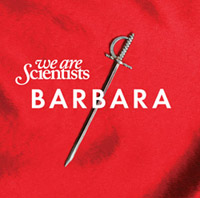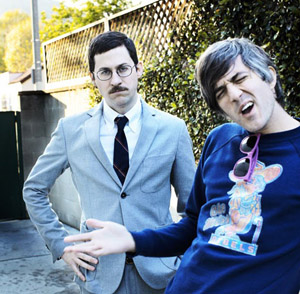We Are Scientists: Birthing “Barbara” At Mission Sound & Beyond
WILLIAMSBURG, BROOKLYN: Barbara. What does this mystical word evoke in your imagination? For We Are Scientists, this isn’t just a likely moniker for the hairdresser down the block. No no: It’s the title of their infectiously delicious new album. It’s a woman you want to get to know.
This week marks the release of disc #4 from WAS, and it’s a musical milestone worth noting. The Brooklyn-based duo of Keith Murray and Chris Cain rock melodic all across the 10 songs here, energized by the punch of new drummer Andy Burrows and fully focused on a tighter sound.
Working with producer/engineer Ariel Rechtshaid, We Are Scientists hopped from NYC to LA to London to bring Barbara into the world, in all her glory. Once you dig into these hooks, we dare you to forget them. Wait! Make that a DOUBLE DOG DARE.
The new album sounds terrific. What was the recording philosophy going in?
Our starting point, before we even got going with any songwriting, was the desire to return to being a three-piece on stage. We spent the last album cycle (2008’s Brain Thrust Mastery) touring with a fourth man on keys and second guitar.
While it was a lot of fun, and the songs on that album — with all their four and five-piece arrangements — remain some of our favorites, two years of that left us yearning for the excitement and simplicity of the trio: three instruments, three voices, as much noise as possible.
So we wrote songs for three pieces, and when we went into the studio to record them, we wanted to make sure the end result sounded like just three people, that reproducing the songs live would be feasible for a three-piece.
That’s logical. How did that affect your choice of studios, which spanned NYC, London and L.A.? Where did you record in each city, and why?
I’d say our studio choice was a balance of financial responsibility, logistical requirements, and the knowledge that the record needed to sound decent or people would make fun of us.
We’re putting this album out on our own label, Masterswan Recordings, which despite an association with glamorous peregrinations and flagrant excess is actually just Keith and my laptops and bank accounts, so our sensitivity to recording costs was fairly high.
Luckily, these days, when you cut money from the studio budget, that tends to mean the lounge isn’t full of brand new furniture, or the TV in the lounge isn’t 3D, or one of the controllers for the XBOX is missing. Thanks to the state of technology, even very inexpensive studios have everything necessary to record top-notch sounds. The logistical concerns arose from our decision to record with a drummer who lives in London and a producer who lives in LA. So all of us did some traveling once or twice, and we ended up doing sessions in London, NYC, and LA (at Strongroom, Mission Studios, and Sunset Lodge, respectively).
It’s the global village! Tell us more about what led you to Mission Sound in Brooklyn. What made it the right place for you to work, and which songs from Barbara were recorded there?
We discovered Mission Studios because Arctic Monkeys used it for some of their last record, and we dropped by a few times to fray power cables, pour laxative into the coffee pot, and generally do whatever we could to slow that monolithic band’s steady ascension into the western musical canon.
While our focus was sabotage, we couldn’t help noticing the homey splendor of Mission Studios. When it came time to book something in New York, we were surprised and delighted to find that this place was within our budget. We ended up recording drums and bass for “Nice Guys,” “Foreign Kicks,” “You Should Learn,” and b-sides “Pound for Pound” and “Down the Hall,” all in a fairly intense two-day session engineered by local maestro Chris Coady.
Let us inside your Scientist™ brains: What are one or two new recording tips that you learned recording Barbara?
 I learned that, at least with our recording approach, the actual bass guitar you’re using is much more important than amps, pedals, mics, etc., in getting a good bass sound.
I learned that, at least with our recording approach, the actual bass guitar you’re using is much more important than amps, pedals, mics, etc., in getting a good bass sound.
In LA we had access to a rental place with an amazing range of instruments that they let us take back to the studio and pay for only if we ended up using them on the record. So I blew through about six classic basses before striking gold with a ’76 Gibson Ripper. We spent nearly a day fiddling with an old Ampeg set-up that belongs to our producer to get the sound that we used throughout the first guitar’s session. It sounded great, but it was no accident.
After that session, I spent a week hunting down a nearly-identical Ripper to eventually take on tour. And the nifty thing was that when we did the final drum work at Mission Studios, we went ahead and recorded scratch bass using my new Ripper through a D.I., and it sounded so good afterward that it went on the album.
For an example of the bass recorded through the arduously tweaked Ampeg, see “Rules Don’t Stop” or “Break It Up”; for the bass through a D.I., see “Foreign Kicks.” Sorry, that was a long, nerdy story. I can’t even re-read it, and it’s my story.
Nah, we love nerdy gear stories! Moving on to the mix, who mixed the album and where? And what was different about having your new drummer, Andy Burrows’, drums in the mix? What other factors affected how “Barbara” was constructed differently?
The incomparable Dave Schiffman mixed the album at his home desk in Los Angeles. I never even saw the set-up. Dave would just send us test mixes to listen to and we’d email back comments. He was fast and effective as hell.
Andy’s the best combination of “expressive” and “tight” that I’ve ever seen in a rock drummer. I think from a production/mixing standpoint he’s kind of a dream to work with because when you record him, his instincts are so good.
It’s always worth pushing Andy for an extra fill idea because nearly every one he spits out is useable and awesome. His beats are very creative but in a way very conservative in that they always, always serve the song, not the drummer’s much-mythologized desire to lay down beats that grab your attention. So I think we and Ariel and Dave — producer and mixer respectively — had an unusually clean set of drum recordings, and also an unusually rich, coherent set of options, when putting together the final tracks.
Other than that, the big difference with Barbara was the staggered recording sessions. In the past we’ve always gone in for a couple weeks and banged out the album. This time we had several multi-week breaks, which could’ve hurt momentum, I guess, but instead gave us plenty of time to let ideas marinate and to make sure everything sounded the way we wanted it to.
There was an opportunity to live with choices for a while, and then to change them if we wanted to. In short, we were able to fix all of the problems that would otherwise have made it to press, resulting in an indisputably perfect record. Trust me!
The proof is in the listening: We can’t get “Jack and Ginger” out of our heads. Tell us something surprising about how this song was written or recorded.
I can tell you that the synth line in the verse, which is a pretty big hook, was kind of an afterthought — the song was written with no keyboards (actually, there was originally an organ filling out the mix, but no lead synths). We were working in Ariel’s guest house/studio after all of the recording was done, just getting rough mixes together, and he started fiddling with a lead synth line that immediately engaged all three of us.
We spent five or ten minutes honing the exact melody to where it is on the record, and suddenly realized with some horror that we had broken the Prime Directive for this record: we had added a fourth fucking instrument to a track. It really tortured us, actually, the decision of whether to leave that synth line on there or not. In the end we decided that the song would still sound good live without the synth – it would just be different.
And there’s no rule that says the live version has to accord perfectly with the record. Over the course of the few shows we’ve done thus far on Barbara, though, we’ve always had one idle friend or another come out and play that part whenever an idle friend was to be found.
Honing in on the homeland, what borough/neighborhood of NYC are you based out of? After having traveled the planet over, why do you still think NYC is the place to be?
I’d say we’re based out of Brooklyn. Since we moved here back in 2001, I’ve lived in Manhattan and Keith has lived in Brooklyn, but we’ve always practiced in Brooklyn, and that seems like the musical seat of the band. I guess?
Maybe we’re pan-New York. I suppose I wouldn’t call us an intrinsic part of “the Brooklyn scene” the way maybe a Dirty Projectors or a Grizzly Bear are. Let’s say we’re pan-New York with a Brooklyn bent.
New York City is the place to be because the number of top-notch restaurants is staggering; the people are (contrary to legend) very approachable; the people are serious about accomplishing their goals, and act like it; the people are fucking good looking; the city is fucking good looking; the city is easier and cheaper to navigate than any competing metropolis; and the city (in keeping with legend) has everything you could possibly want to watch, listen to, taste, interview, photograph, fuck, read, or record. — David Weiss
Please note: When you buy products through links on this page, we may earn an affiliate commission.








Kerstin
June 17, 2010 at 2:43 am (14 years ago)that was a very good interview. thank you for not asking basic questions. very interesting to learn more about the recording process etc. 🙂
Kerstin
June 17, 2010 at 9:43 am (14 years ago)that was a very good interview. thank you for not asking basic questions. very interesting to learn more about the recording process etc. 🙂